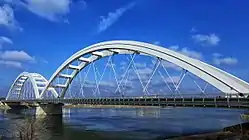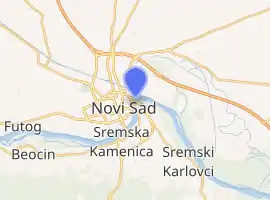Žeželj Bridge
Žeželj Bridge (Serbian: Жежељев мост, romanized: Žeželjev most) is a tied-arch bridge on Danube river in Novi Sad, Vojvodina, Serbia. The bridge was originally built in 1961, only to be destroyed during the 1999 NATO bombing of Yugoslavia. The newly constructed bridge was opened in 2018.
Žeželj Bridge Žeželjev most Жежељев мост | |
|---|---|
 Žeželj Bridge in February 2018 | |
| Coordinates | 45°15′43.7″N 19°51′36.9″E |
| Crosses | Danube |
| Locale | Novi Sad, Vojvodina, Serbia |
| Official name | Žeželj Bridge |
| Named for | Branko Žeželj |
| Maintained by | Serbian Railways Infrastructure |
| Preceded by | Road–Railway Bridge |
| Followed by | Beška Bridge |
| Characteristics | |
| Design | Tied-arch bridge |
| Material | Steel |
| Trough construction | Steel |
| Pier construction | Reinforced concrete |
| Total length | 474 m |
| Width | 32 m |
| Traversable? | Yes |
| Longest span | 219 m |
| No. of spans | 2 |
| Piers in water | 1 |
| No. of lanes | 2 |
| Rail characteristics | |
| No. of tracks | 2 |
| Track gauge | 1,435 mm (4 ft 8 1⁄2 in) |
| Electrified | Yes |
| History | |
| Designer | Branko Žeželj (original bridge) Aleksandar Bojović (new bridge) |
| Construction start | 1957 (old bridge) 2012 (new bridge) |
| Construction end | 1961 (old bridge) 2018 (new bridge) |
| Opened | 1961 (old bridge) 2018 (new bridge) |
| Collapsed | 1999 |
| Location | |

| |
History
The original Žeželj Bridge (377 meters long) was a through arch bridge built between 1957 and 1961. It was designed by the prominent Yugoslavian civil engineer Branko Žeželj and constructed by Mostogradnja.[1][2] It connected the city area of Novi Sad and Petrovaradin. During its existence, it served as part of an international railway line and as a transit road through Novi Sad.[2]

During the NATO bombing of Yugoslavia, the bridge was bombed 12 times. On 23 April 1999, it was finally destroyed, cutting railway transport between Belgrade and Subotica, i.e. Serbia and Hungary.[3] During the NATO bombing, all three large bridges on Danube river in Novi Sad (Žeželj Bridge, Varadin Bridge and Liberty Bridge) were completely destroyed.
In 2000, a temporary Road–Railway Bridge was constructed near the Žeželj Bridge to serve as a replacement of Žeželj Bridge until the new one was constructed. Over the years, the construction of the new Žeželj Bridge was postponed several times.[4]
In April 2012, the construction works for the new bridge in the same place officially started.[5] The main designer of the new bridge was Aleksandar Bojović, while the contractor was an international consortium, JV Azvi - Taddei – Horta Coslada.[6] The new bridge is visually similar to the destroyed bridge, except that the arches are made from steel and not prestressed concrete.[7] The bridge consists of two arches, the larger one being 219 metres (719 ft) long and 42 metres (138 ft) high and the smaller one 177 metres (581 ft) long and 34 metres (112 ft) high.[7]
In October 2017, the arches of Žeželj Bridge were connected after five years of construction and eighteen years after the previous bridge was destroyed.[8] As of October 2017, the construction works cost was 51.71 million euros.[8] In April 2018, the bridge was completed and regular rail transport established.[9] The vehicle transit was established on 1 September 2018.[10]
References
- Mijatović, Vuk (15 July 2013). "Branko Žeželj: Čovek koji je ukrotio beton". novosti.rs (in Serbian). Retrieved 7 April 2018.
- Tucakov, Joza (17 November 2010). "Novi Sad i njegovi rušeni mostovi". b92.net (in Serbian). Politika. Retrieved 7 April 2018.
- "Pre 15 godina srušen Žeželjev most". b92.net (in Serbian). Dnevnik. 26 April 2014. Retrieved 3 April 2018.
- "Žeželjev most gradi se na leto". b92.net (in Serbian). Beta, Tanjug. 25 January 2011. Retrieved 3 April 2018.
- "Počela izgradnja novog Žeželjevog mosta". novosti.rs (in Serbian). Tanjug. 21 April 2012. Retrieved 3 April 2018.
- Kovačević, Snežana (25 January 2018). "Kako će se zvati Žeželjev most". politika.rs (in Serbian). Retrieved 3 April 2018.
- Čonkaš, Z. (20 October 2017). "Sastavljen Žeželjev most na Dunavu kod Novog Sada". blic.rs (in Serbian). Retrieved 3 April 2018.
- Ковачевић, Снежана (22 October 2017). "Поново пешице преко Жежељевог моста". politika.rs (in Serbian). Retrieved 3 April 2018.
- "NS: Napokon saobraćaj preko novog mosta - 160 km/h". b92.net (in Serbian). Tanjug. 2 April 2018. Retrieved 3 April 2018.
- "Otvoren Žeželjev most za drumski saobraćaj". rtv.rs (in Serbian). Tanjug. 1 September 2018. Retrieved 22 January 2019.
External links
| Wikimedia Commons has media related to Žeželj Bridge. |
- Žeželj Bridge at structurae.net
